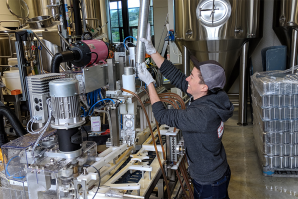To visit the newest state park is to travel back 150 years when Central California was wetter, greener and lusher. The Sacramento, San Joaquin and other great rivers flowed beyond their current banks and into wetlands and other riparian habitat. Back then, such areas were considered swamplands and something to be destroyed. Now we call them “wetlands” and spend millions restoring them.
Dos Rios State Park is located eight miles west of Modesto at the confluence of the San Joaquin and Tuolumne rivers. It’s the state’s most visible example of rebuilding wetlands along river corridors. But it’s not the first and won’t be the last. Both the state and federal governments have budgeted money for similar projects in California.
California wildrose is one of more than 15 species of native
plants and shrubs that have been planted at Dos Rios Ranch.

Dos Rios Ranch is scheduled to open June 12. California State Parks and the nonprofit organization River Partners, which is co-developing the park with the state, gave Comstock’s an advance preview of the park over the Memorial Day weekend. For the initial opening phase of the park, visitors can take guided tours to view the riparian forest on the 1,600-acre former ranch. For now, the only amenities are a short trail and covered picnic tables with grills, near the entrance and overlooking a lake.
The California State Park and Recreation Commission will eventually have to sign off on a plan for how to develop the park. Commissioners will consider how to improve river access for fishing, swimming, boating and other water activities, among other things, according to Park Manager Paige Haller. They will also approve the park’s name; “Dos Rios” is temporary, although it may stick.
When River Partners started the habitat restoration 11 years ago, it looked a lot like the area surrounding it — farmland, without a lot of vegetation, says Alex Karolyi, a River Partners spokesperson. With funding from a variety of public and private sources, River Partners transformed the property by putting in more than 350,000 native plants and shrubs. Native varieties of oak, cottonwood, ash and other trees and shrubs fill much of the land, along with rye, milkweed, sedge and other herbs and grasses.
River Partners purchased Dos Rios Ranch for $21.8 million and restored it for $20.5 million.
The Tuolumne River runs along the northern edge of Dos Rios State
Park. The river starts in Yosemite National Park.

If you’re used to the area’s farming monoculture (just one type of product grown on a farm), the variety of the riparian forest can come as a shock. An estimated 95 percent of the Central Valley’s historic wetlands were lost to development and other factors. Filling in wetlands allowed our cities to grow and our agriculture to become a global powerhouse. But it was also bad for plants, as well as birds, fish, and other animals.
Birds and other animals seem to love Dos Rios Ranch. Quail and rabbit scurry across the roads. Birdsong is everywhere. Western meadowlarks, red-tailed hawks, California quails and many other birds can be heard and seen.
The park provides habitat for 10 priority species. Restoration at Dos Rios Ranch contributes to ongoing efforts to recover populations of the endangered riparian brush rabbit, one of the state’s most endangered wildlife species, according to River Partners.
By allowing excess water to flow into floodplains, Dos Rios Ranch improves flood safety for downstream communities and recharges aquifers, Karolyi says. River Partners also redeveloped the floodplains at the San Joaquin River National Wildlife Refuge, located across the river from Dos Rios Ranch, “creating one of the largest contiguous floodplains in the Central Valley,” according to the nonprofit.
A red-tailed hawk flies over Dos Rios. Riparian forests like
those at Dos Rios Ranch are a favorite habitat for the raptors.

The last addition to the state park system was Eastern Kern County Onyx Ranch State Vehicular Recreation Area in 2014. The last place designated a “state park” was Fort Ord Dunes State Park in Monterey County in 2009. So, it is understandable why state officials refer to Dos Rios Ranch as a “game changer,” a place that can be developed for environmental needs while also serving the recreational interests of the public.
Last year, River Partners started restoring Hidden Valley Ranch, which is next to Dos Rios Ranch. The nonprofit hopes to make it part of the state park system, too.
–
Subscribe to the Comstock’s newsletter today.
Recommended For You

Vino Madre
Juicy scenes from the wine tasting room at the first Terra Madre Americas
For three days in May, the floor of the Memorial Auditorium was transformed into a global foodways classroom where one could sample coffee from Honduras, eat a cookie made from Bolivian quinoa and spin an oversized wheel that directed you to pithy sayings by food journalist Michael Pollan.

Sacramento Goes Global With New Food Conference
Terra Madre has potential to shine a ‘huge culinary spotlight’ on the city
Sacramento will serve as the site of a prestigious international food conference that could eventually bring thousands of tourists and millions of dollars into the region.

The Canned Craze
Canned cocktails and wines are light and easy to tote, perfect for a backyard barbecue, summer concert, picnic or anytime
The canned alcohol trend isn’t hard to spot. Just stroll through your local grocery store and you’ll see those colorfully packaged cans of prosecco and prickly pear margaritas all dressed up and ready to go, perfect for a picnic or poolside party.

Is Tea the New Happy Hour?
These Capital Region tea rooms bring a California twist to an English tradition
Afternoon tea evokes something people have always sought — “a feeling of rarely experienced elegance and class,” Mueller says.

The Thrill of the Ring
Sacramento’s small-town professional wrestling scene is just as colorful as the big league
The alley entrance of a warehouse behind the Broadway Taco Bell on a recent Saturday was a portal to another world. A world of drama, where fans chanted and booed lustily, the air redolent of masculine funk.



